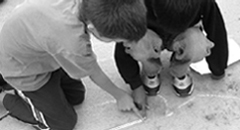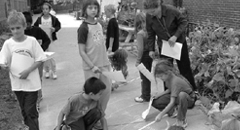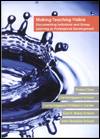
|

|

|
MLV at Home in the U.S.
 In Phase II of the project, the Project Zero team explored the role of documentation of individual and group learning in the context of pre-K through grade 8 education in the U.S. All indications from the second phase are that these ideas, while extremely challenging in the context of U.S. values and educational practice, are also very attractive to American teachers and relevant to the learning experiences of older children. Teachers find the frameworks for understanding learning groups and documentation a valuable form of professional support as they apply these ideas in their classrooms. Along with eight Massachusetts teachers, we wrote a book, Making Teaching Visible: Documenting Individual and Group Learning as Professional Development (Project Zero et al., 2003), that describes this work.
In Phase II of the project, the Project Zero team explored the role of documentation of individual and group learning in the context of pre-K through grade 8 education in the U.S. All indications from the second phase are that these ideas, while extremely challenging in the context of U.S. values and educational practice, are also very attractive to American teachers and relevant to the learning experiences of older children. Teachers find the frameworks for understanding learning groups and documentation a valuable form of professional support as they apply these ideas in their classrooms. Along with eight Massachusetts teachers, we wrote a book, Making Teaching Visible: Documenting Individual and Group Learning as Professional Development (Project Zero et al., 2003), that describes this work.
Key findings from Phase II include:
- Forming and nurturing learning groups is appropriate across grade levels (pre-K-8). Learning in groups deepens students' understandings of diverse subject matter and heightens their awareness of ways of learning and working with each other.
- Documentation of student learning and work across these grade levels supports the learning of teachers as well as students. Teachers learn about their own roles in learning groups (e.g., when to intervene and when to stand back) and about the factors that contribute to making a learning group effective.
- Documentation of learning groups provides new insights into what students are working to understand and how teachers might help them move forward in their learning. Reviewing documentation has influenced curriculum in terms of the amount of time a group spends on a topic and the level of student involvement in shaping an activity or unit.
- The aesthetic dimension of learning in groups is compelling for both students and teachers, providing points of engagement and ways to guide and sustain the learning process. The aesthetic dimension refers to aspects of the learning environment and materials as well as to the structures and presentation of ideas that stir students' emotions, engage their minds, and foster the creation of quality work. To address this dimension, teachers might attend to a range of issues including classroom set-up, the use of drama and fantasy in the curriculum, and the design and presentation of documentation to students and others.
- Cooperation and collaboration are distinct from one another in the functioning of a learning group. When teachers encourage cooperation, they tend to emphasize getting along, being helpful, and taking an assigned role in a group. While this can be very valuable, collaboration seems to provide a more powerful environment for thinking and learning--drawing students into direct engagement with each other's ideas and ways of thinking through working together to solve problems and make products.
- Documenting student work and learning effectively entails the use of models, mentoring, considerable practice, and an informed and thoughtful audience to provide feedback. With such supports, documentation can become a valuable tool for enriching teaching and learning in the classroom.
[Home] [Site Map]